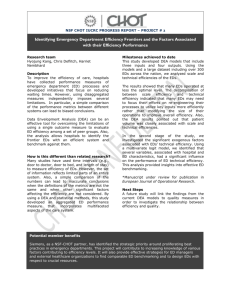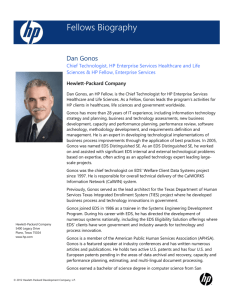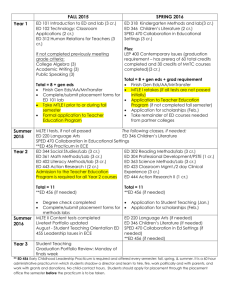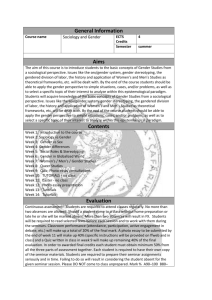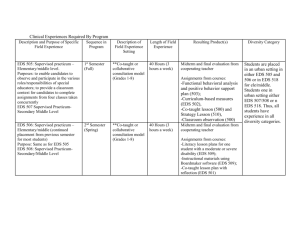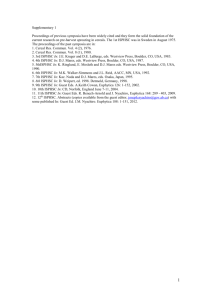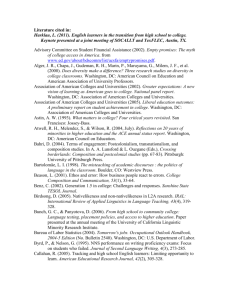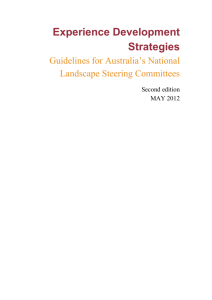EDS Guidelines
advertisement
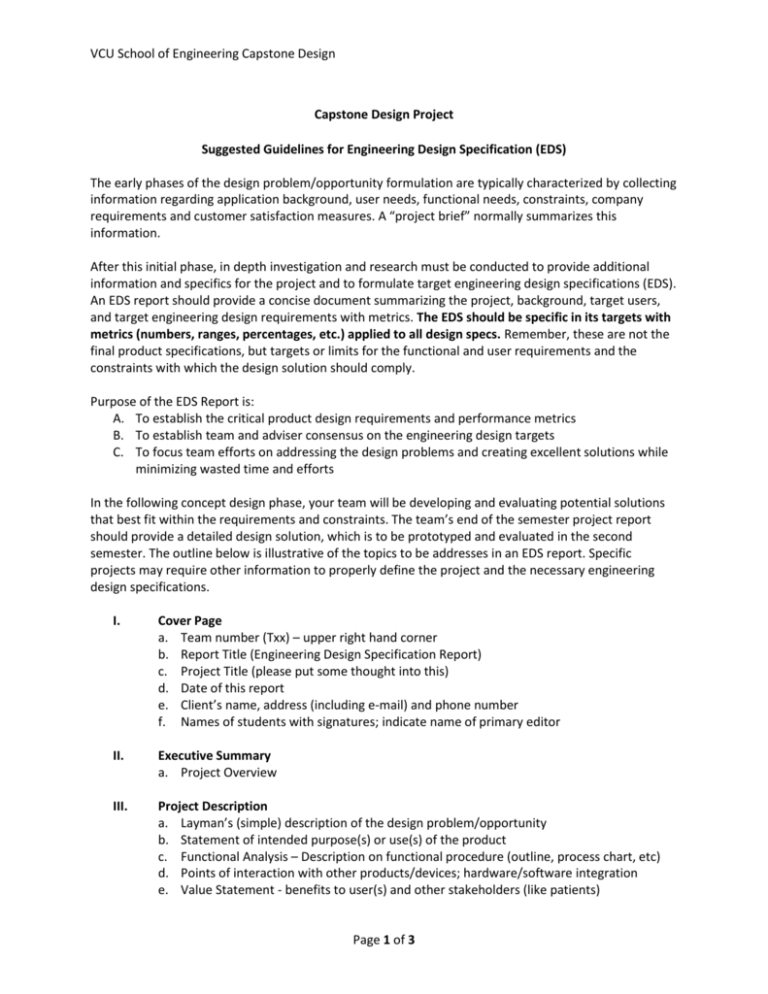
VCU School of Engineering Capstone Design Capstone Design Project Suggested Guidelines for Engineering Design Specification (EDS) The early phases of the design problem/opportunity formulation are typically characterized by collecting information regarding application background, user needs, functional needs, constraints, company requirements and customer satisfaction measures. A “project brief” normally summarizes this information. After this initial phase, in depth investigation and research must be conducted to provide additional information and specifics for the project and to formulate target engineering design specifications (EDS). An EDS report should provide a concise document summarizing the project, background, target users, and target engineering design requirements with metrics. The EDS should be specific in its targets with metrics (numbers, ranges, percentages, etc.) applied to all design specs. Remember, these are not the final product specifications, but targets or limits for the functional and user requirements and the constraints with which the design solution should comply. Purpose of the EDS Report is: A. To establish the critical product design requirements and performance metrics B. To establish team and adviser consensus on the engineering design targets C. To focus team efforts on addressing the design problems and creating excellent solutions while minimizing wasted time and efforts In the following concept design phase, your team will be developing and evaluating potential solutions that best fit within the requirements and constraints. The team’s end of the semester project report should provide a detailed design solution, which is to be prototyped and evaluated in the second semester. The outline below is illustrative of the topics to be addresses in an EDS report. Specific projects may require other information to properly define the project and the necessary engineering design specifications. I. Cover Page a. Team number (Txx) – upper right hand corner b. Report Title (Engineering Design Specification Report) c. Project Title (please put some thought into this) d. Date of this report e. Client’s name, address (including e-mail) and phone number f. Names of students with signatures; indicate name of primary editor II. Executive Summary a. Project Overview III. Project Description a. Layman’s (simple) description of the design problem/opportunity b. Statement of intended purpose(s) or use(s) of the product c. Functional Analysis – Description on functional procedure (outline, process chart, etc) d. Points of interaction with other products/devices; hardware/software integration e. Value Statement - benefits to user(s) and other stakeholders (like patients) Page 1 of 3 Engineering Design Specifications 2015-16 LF Bost, BC Ward f. Description of product user(s) (i.e. type physician, nurse, manufacturing engineer, etc.) g. Operating environment for product h. Market Information 1. Number of potential procedures/uses per year (with references) 2. Information on current competitive products/procedures 3. Target market sales price; with a brief justification comparing to predicate device(s) or methodologies i. Special features j. Potential FDA / EPA product classification and regulatory pathway IV. Engineering Design Specifications a. Customer Requirements 1. Human factors considerations 2. Metrics for customer satisfaction 3. Single use (consumable device) or reusable 4. Sterile or non-sterile product b. Functional Requirements (What should the product do?) c. Performance Metrics (How well should it do “it”?) d. Engineering Characteristics (units, ranges, limits with tolerance ranges, etc) 1. Size, dimensions, weight (should be constant with medical application norms) 2. Mechanical properties 3. Material properties 1. Important material surface characteristics and properties 2. Biocompatibility issues 3. Electrical, non-electrical requirements 4. Any other characteristics specific to this project e. Constraints 1. Does this product have to function with specific other products? i.e. If computer program is part of design, what is spec on required hardware, etc. 2. Does solution have to utilize specific materials or manufacturing processes? 3. Target manufacturing cost (materials and assembly) f. Production Methods 1. Appropriate manufacturing methods based on scale of components and design requirements 2. Sterilization or cleaning methods based on materials used (if applicable) 3. Quality Requirements with Allowable Tolerance levels 4. Packaging and Storage Requirements 5. Brief cost analysis V. Project deliverables, not limited to the following: 1. Project plan and timetable with milestones for remainder of this semester (Please provide a well defined Gantt Chart) 2. How is team going to keep adviser informed? (Bi-weekly progress memorandums to the client with a statement as to how these will be transmitted (e.g. hard copy, e-mail, etc), with copy to instructor. 3. For team’s final report what does team currently anticipate they will include: such as: concept drawings, CAD drawings of design solution, Bill of Components and Page 2 of 3 Engineering Design Specifications 2015-16 LF Bost, BC Ward Materials. 4. Client reviews and user evaluation Report Format: Maximum of 8 pages in length (excluding cover page, reference page and addendums) using 12-point type, 1.5 line spacing, with 1” margins. Use headings, tables and charts where appropriate. Pages should be numbered (Page x of y) at bottom of the page. No number on title page. Addendum - No more than 5 pages of addendum. Figures, sketches, tables, photos may be attached in addendum. If figures, sketches, tables, photos are included within text, the document maximum is 13 pages. All figures and tables should be clearly labeled. Format for References: Journal of the American Medical Association (JAMA) style http://library.uwaterloo.ca/discipline/opt/JAMA.html Note: Suggest using EndNote (available GT OTL software site) or Zotero Submission: Turn in a hard copy of the report at class time on due date and submit an electronic copy to the instructor, adviser and TA. Be sure to put the team number and report type in subject line of email and in name of file. i.e. “Txx EDS Report” Text Reference: P.H. King and R.C. Fries, Design of Biomedical Devices and Systems, Second Edition, CRC Press, 2009 Page 3 of 3
